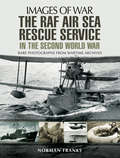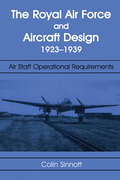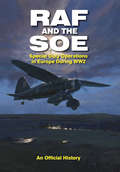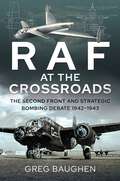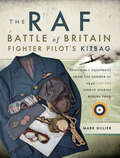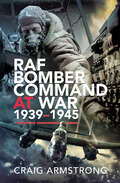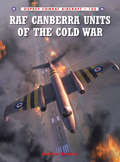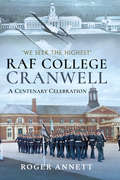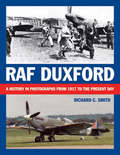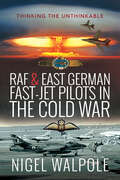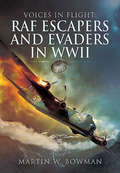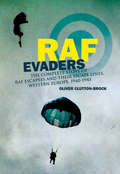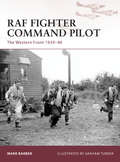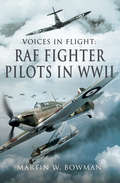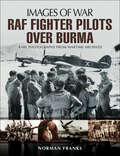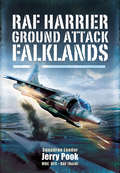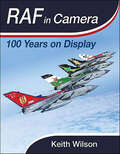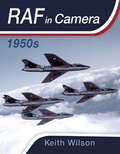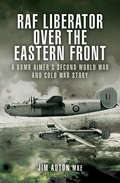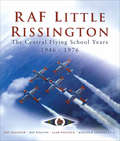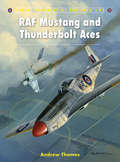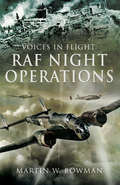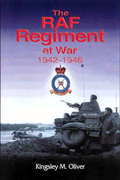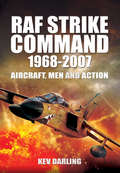- Table View
- List View
The RAF Air-Sea Rescue Service in the Second World War (Images Of War Ser.)
by Norman FranksWhen the Second World War began in 1939 it was thought that it would be fought along the same lines as the First World War, with the Allied air forces operating from both Britain and France. With the fall of Britains Northern European Allies in May 1940, all that changed. From then onwards, RAF aircraft operating over enemy and enemy-held territory necessitated flights across both the North Sea and the English Channel.This meant that aircrew in difficulties would be forced to come down in both of these bodies of water. Therefore it was essential that some form of rescue service be made available to fish these airman from the water. But there were no aircraft in existence at that time that were designed for such a task: initially all that could be done was to use land planes to help locate anyone in the water, drop a dinghy to them, and then guide a boat to their position.Obviously a quicker and more reliable means of rescue was needed, and this came in the shape of the Supermarine Walrus, an amphibian airplane that could land on both sea and land. Several Flights of these airplanes were set up around the coast of Britain, concentrated mainly around the south and southeast of England. The Air Sea Rescue airmen did a magnificent job from 1941-45, rescuing hundreds of downed RAF and USAAF aircrew. It took a special type of airman to undertake these rescues and another kind of courage.As the war in North Africa developed, Walrus aircraft were needed in the Mediterranean, and later on either side of the Italian coast. Walrus squadrons operated just as successfully in this theater as around Britain. Aircrew operating over any stretch of water could always count on the ASR boys coming to their aid. This is their story.
The RAF and Aircraft Design: Air Staff Operational Requirements 1923-1939 (Studies in Air Power #Vol. 9)
by Colin S SinnottThis work examines the evolution of the RAF's operational requirements for its home defence air force - for bombers to mount a deterrent counter offensive and for fighters to provide direct defence of Britain. It discusses the management processes, policies and decisions relevant to operational requirements on the basis of a detailed study of Air Ministry papers of the time. By tracing the development of operational requirements, the author exposes the thinking behind the RAF's quest for effective fighter and bomber aircraft. He describes the ideas and concepts of air warfare that were adopted in the 1920s, and shows how these evolved into the Air Staff's requirements for the aircraft which the RAF entered and fought in World War II.
RAF and the SOE: Special Duty Operations in Europe During WW2
by John GrehanThe Special Operations Executive developed a vast network of agents across Occupied Europe which played a vital role in developing and sustaining Resistance movements that persistently sought to subvert German control of their territories. The culmination of their efforts was seen when the Allied armies landed at Normandy in June 1944, with the SOE and the Resistance causing widespread destruction and disruption behind the German lines.None of this would have been possible had it not been for the Royal Air Force. Not only the RAF supply the SOE, and the movements it led and coordinated, with the thousands of tons of arms and equipment needed to undertake this role, it also delivered and retrieved agents from under the very noses of the enemy.Compiled at the end of the war by the Air Historical Branch of the RAF, this is an extremely detailed and comprehensive account of the RAFs support for the SOE, and in it we learn of the enormous and complex arrangements undertaken by the Special Duties squadrons as well as showing how the material delivered by these aircraft was used in the field.This account is reproduced here in its entirety, along with a detailed appendix containing the official historical record of Bomber Command aircrews and aircraft engaged in clandestine operations. Taken together, this book represents the most comprehensive account of the RAFs support for SOE ever published.
RAF at the Crossroads: The Second Front and Strategic Bombing Debate, 1942–1943
by Greg BaughenThe events of 1942 marked a pivotal year in the history of British air power. For more than two decades the theory that long-range bombing could win wars had dominated British defense policy. The vast majority of warplanes ordered for the RAF were designed either to bomb enemy cities or stop the enemy from bombing British cites. Conventional armies and the air forces that supported them were seen as an outmoded way of waging war. During 1941 evidence began to mount that British policy was wrong. It had become clear the RAF’s bomber offensive against Germany had, until that point, achieved very little. Meanwhile, the wars raging in Europe, Africa and Asia were being decided not by heavy bombers, but by armies and their supporting tactical air forces. Britain had never had the resources to build a large army as well as a strategic bomber fleet; it had always had to make a choice. Now it seemed the country might have made the wrong choice. For the first time since 1918 Britain began thinking seriously about a different way of fighting wars. Was it too late to change? Was a strategic bombing campaign the only option open to Britain? Could the United Kingdom help its Soviet ally more by invading France as Stalin so vehemently demanded? Could this be done in 1942? Looking further ahead, was it time to begin the development of an entirely new generation of warplanes to support the Army? Should the RAF have specialist ground attack aircraft and air superiority fighters? The answers to these questions, which are all explored here by aviation historian Greg Baughen, would help shape the development of British air power for decades to come.
The RAF Battle of Britain Fighter Pilot's Kitbag: Uniforms & Equipment from the Summer of 1940 and the Human Stories Behind Them
by Mark HillierThe scenes are familiar ones; the young Brylcream Boys sat at dispersal waiting for the haunting call of Scramble, lounging in their shirt sleeves and fur-lined boots, their leather flying helmets lying limp by their side. But what did the RAF fighter pilots of the Battle of Britain really wear, and what vital items would their kitbags have held?The casual air of the dashing pilots of Fighter Command in the Spitfire Summer of 1940 conceals a necessarily professional approach to their task of holding Hitlers Luftwaffe at bay. Therefore, each item of clothing and equipment they wore and carried had a role and a function, be it for warmth and comfort, communication, or for fighting and survival.All the objects that an RAF fighter pilot was issued with during the Battle of Britain are explored in this book in high-definition color photographs, showing everything from the differing uniforms, to headgear, personal weapons, gloves, goggles, parachute packs and the essential Mae West life jacket. Each item is fully described and its purpose and use explained.Relive Britains finest hour as never before through the actually clothing and accouterments of The Few.
RAF Bomber Command at War, 1939–1945
by Craig ArmstrongThe Royal Air Force had placed a great deal of faith in its force of bombers, Bomber Command, in the event of a future war. The belief in the ability of formations of bombers flying in daylight and unescorted, protecting themselves from enemy fighter attack, informed early tactics but led to bloody losses. Hampered by government restrictions on targets, by late 1941 Bomber Command was in crisis. As a result, and coupled the growing dire war situation, a new and forceful commander, Sir Arthur Harris, was appointed and new strategies allowed Bomber Command to broaden its attacks despite some opposition. The result was the area bombing strategy which focussed attacks upon enemy held towns and cities. This Main Offensive period lasted throughout 1943-1944 and saw both victories and defeats. It was also the period that saw a limited number of precision attacks; on Augsburg, Peenemunde and, most famously, the Ruhr dams. Bomber Command also aided in tactical and strategic support for the invasion of Europe and the subsequent fight to push inland. New technological developments allowed Bomber Command to hit V-Weapons sites and to focus more on precision bombing, but Harris remained determined to hit German towns and cities whenever possible, while the Command's growing power allowed it to rain devastation upon its targets, culminating at Dresden. Much has been written about Bomber Command, but this book focusses largely on those who took part in the raids and on public attitudes towards the campaign in Britain. Using accounts from national and local archives, newspapers and existing historiography, the book seeks to shed light on untold stories from Bomber Command’s war.
RAF Bomber Command at War, 1939–1945
by Craig ArmstrongThe Royal Air Force had placed a great deal of faith in its force of bombers, Bomber Command, in the event of a future war. The belief in the ability of formations of bombers flying in daylight and unescorted, protecting themselves from enemy fighter attack, informed early tactics but led to bloody losses. Hampered by government restrictions on targets, by late 1941 Bomber Command was in crisis. As a result, and coupled the growing dire war situation, a new and forceful commander, Sir Arthur Harris, was appointed and new strategies allowed Bomber Command to broaden its attacks despite some opposition. The result was the area bombing strategy which focussed attacks upon enemy held towns and cities. This Main Offensive period lasted throughout 1943-1944 and saw both victories and defeats. It was also the period that saw a limited number of precision attacks; on Augsburg, Peenemunde and, most famously, the Ruhr dams. Bomber Command also aided in tactical and strategic support for the invasion of Europe and the subsequent fight to push inland. New technological developments allowed Bomber Command to hit V-Weapons sites and to focus more on precision bombing, but Harris remained determined to hit German towns and cities whenever possible, while the Command's growing power allowed it to rain devastation upon its targets, culminating at Dresden. Much has been written about Bomber Command, but this book focusses largely on those who took part in the raids and on public attitudes towards the campaign in Britain. Using accounts from national and local archives, newspapers and existing historiography, the book seeks to shed light on untold stories from Bomber Command’s war.
RAF Canberra Units of the Cold War
by Andrew Brookes Chris DaveyThroughout the Cold War, this 525mph bomber fulfilled the same role as the Mosquito fighter-bomber in World War II. From its first public demonstration at the Farnborough Air Show of 1949, the English Electric Canberra bomber captured the attention of the aviation world. It could outmaneuver all the fighters of the time and it could climb way above their operating ceilings. Yet this bobmer was simple to maintain and a delight to fly, although it could punish any pilot who did not treat it with respect. The Canberra B 2 first flew on April 21, 1950 and entered frontline service with No 101 Sqn in May 1951. In a testament to the aircraft's benign handling characteristics, the transition program consisted of only 20 hours in the Gloster Meteor and three hours in the dual-control Canberra trainer. With a maximum speed of 470 knots (871 km/h), a standard service ceiling of 48,000 ft (14,600 m) and the ability to carry a 3.6-tonne (7,900-lb) payload, the Canberra was an instant success. Of the 42 RAF Canberra B 2 squadrons, 24 served in Bomber Command, four in Cyprus, one in the Far East and nine on special duties. The next bomber version was the B 6, of which ten squadrons served in Bomber Command, two in Cyprus and one in the Second Allied Tactical Air Force (2nd ATAF). Six B 15/B 16 squadrons served in Cyprus and the Far East, and five squadrons of B(I) 8s were assigned to the Supreme Allied Commander Europe's tactical nuclear force in 2nd ATAF. In addition, 19 squadrons of PR Canberras served in the photo-reconnaissance role. The Canberra PR 9, the last Canberra in RAF service, retired on June 23, 2006, 57 years after the first Canberra flight.
RAF College, Cranwell: A Centenary Celebration
by Roger AnnettA history of Great Britain’s Royal Air Force College in Cranwell, told from the perspective of former cadets.“We Seek the Highest” has been the motto of the thousands of Officer Cadets who, over ten decades, have passed through the rigorous training regime at the Royal Air Force College, Cranwell, Lincolnshire. The words embody the College ethos: to strive to reach the tough standards demanded by the RAF, in the air and on the ground.This book tells the 100-year story from the point of view of the Officer Cadets themselves. The College was founded in 1919—some eighteen months after the birth of the RAF itself—with the aim of providing a cadre of disciplined, highly trained officers, ready to lead the service through the uncertain postwar and post-Empire times to come. Since then, it has responded continuously to the UK’s political, economic, and military requirements.The RAF Officer Cadets’ world has thus been one of change. The author documents these changes from 1919 to today, overlaying the historical and social scene with the candidly related airborne and ground-based exploits of three-score ex-cadets.The core narrative is based on the three years at Cranwell of 81 Entry of Flight Cadets, who graduated in July 1962 with thirty-seven jet pilots and eight navigators, having launched a curriculum-changing experiment in degree-level studies.With a foreword from an Air Chief Marshal former cadet, 130 illustrations, and a full index, this is a cadets’ tribute to a world-famous military academy on its centenary.
RAF Duxford: A History in Photographs from 1917 to the Present Day
by Richard C. SmithA pictorial account of the airfield&’s 90-year history—from WWI to housing the largest collection of war and peacetime vintage aircraft in Europe. Established in 1917 to train Royal Flying Corps aircrew, during WWI Duxford was also the base for two United States Aero Squadrons, 137 and 159, and by the end was a mobilization airfield for three DH9 day bomber squadrons. During the 1920s and 30s, expansion continued apace, with three fighter squadrons, 19, 29 and 111, and the presence of many illustrious names, including Harry Broadhurst, Johnny Kent and Frank Whittle. The first aerodrome in Fighter Command to receive the Spitfire (in August 1938), Duxford rose to supreme prominence during the early part of the Second World War. Part of 12 Group detailed to protect the industrial midlands and north east Britain, the base&’s role during the Battle of Britain was mired in controversy due to the &“Big Wing&” tactics of Douglas Bader and Trafford Leigh-Mallory. From October 1942 to the end of the war, Duxford was essentially an American base for, variously the 8th Air Force, 357th and 78th Fighter Groups. Postwar the RAF operated jets from the station until 1961 when the future was put on hold. Managing to avoid the ignominy of becoming a prison or sports complex, the Imperial War Museum finally came to the rescue making Duxford into today&’s premier international air museum. Richard Smith&’s research has led him to numerous previously unpublished collections form which he has unearthed some marvelous images of historical significance. A must for the collector, historian, or veteran of the times.
RAF & East German Fast-Jet Pilots in the Cold War: Thinking the Unthinkable
by Nigel Walpole“You’ll learn what these pilots went through knowing that their actions or reactions could trigger a global nuclear war.” —Historic AviationRAF and East German Fast-Jet Pilots in the Cold War is the result of ten years of research, involving many visits to the former German Democratic Republic by a small Anglo/German team of military specialists. Their purpose was to explore the lives of RAF and East German fighter and ?ghter-bomber pilots, in the air and on the ground, at work and play, during the Cold War in North Germany.The book is based largely on personal testimony from these pilots, coupled with facts drawn from official archives and comment from other historical sources. Where possible, political considerations have been avoided and no outright criticism has been intended, readers being left to draw their own conclusions on the thinking, strategies, equipment and tactics discussed. Far from being an intellectual polemic on the Cold War, the text and photographs merely record a slice of history as seen through the eyes of a select few who took up arms in the defense of their respective homelands—and faced each other daily across the Iron Curtain.In an insightful conclusion, Nigel Walpole reassess the threat that both sides believed was genuine during those tense decades of the Cold War and examines the possible course and nature of a conflict which neither NATO nor the Warsaw Pact wanted but both actively planned for.“The writer has avoided politics where possible, and in doing so reassesses the threat and uncertainty—and ultimately the fears—both air forces faced. It’s truly fascinatingl.” —Flypast
RAF Escapers and Evaders in WWII: Raf Escapers And Evaders In Wwii (Voices in Flight)
by Martin W. BowmanDuring the Second World War, 156 RAF men successfully escaped from German PoW camps in Western Europe. A further 1,975 men evaded capture after having been shot down over this same territory. Martin Bowman has drawn together tales of just a handful of these men, illustrating the bravery and resourcefulness that characterised their experiences. British, American, and Canadian pilot testimonies all feature, as does the fascinating story of a female secret agent, parachuted behind enemy lines. By bringing these stories together, Bowman is able to capture an authentic sense of the times at hand and the reality of life as an escaper/evader during this tumultuous and incredibly dangerous time. This is an entertaining publication set to keep readers on the edge of the seats, and it serves as a tribute to the courageous individuals who found themselves behind enemy lines during the Second World War.
RAF Evaders: The Complete Story of RAF Escapees and their Escape Lines, Western Europe, 1940–1945
by Oliver Clutton-BrockStories of the British airmen shot down over Western Europe who evaded capture by the Germans and made their way to Allied territory during World War II. During the five years from May 1940 to May 1945 several thousand Allied airmen, forced to abandon their aircraft behind enemy lines, evaded capture and reached freedom, by land, sea and air. The territory held by the Germans was immense—from Norway and Denmark in the north, through Holland, Belgium, Luxembourg to the south of France—and initially there was no organization to help the men on the run. The first one to assist the evaders and escapers (&“E & E&” as the Americans called them) was the PAT line, along the Mediterranean coast to Perpignan and down the Spanish border; named after a naval officer Pat O&’Leary, from 1942 it became the PAO line. Next was the Comet line, from Brussels to the Pyrenees. Thousands of brave people were to be involved for whom, if caught, the penalty was death. Theirs is a stirring and awe-inspiring story. Respected historian Oliver Clutton-Brock has researched in depth this secret world of evasion, uncovering some treachery and many hitherto unpublished details, operations and photos. It is a tremendous reference work, written in his own colorful style with numerous anecdotes, which fills a gap of knowledge formerly unavailable to historians, professional or amateur. Packed the information, key figure biographies and listings—2, 094 evaders identified—this is a valuable testimony to the courage of all those involved.
RAF Fighter Command Pilot
by Graham Turner Mark BarberThe recent 70th anniversary of the Battle of Britain, combined with the threat of significant cuts to the current RAF, have highlighted the importance of Fighter Command in the early days of World War II once more. The role of the "few", as described by Churchill, during the Battle of Britain has been the subject of much mythologizing both at the time and in the years since.This title will put Fighter Command in context; describing the lack of funding and attention which it received during the interwar period, until it was almost too late. The myth of the fighter pilot will be humanized, with first-hand accounts quoted which put nervous but brave human beings from all walks of life in the cockpit, not the fearless, arrogant public school boys who appear in popular fiction. Although the Battle of Britain may not have in itself been the decisive encounter that it has historically been portrayed as, the moral victory won by the RAF, the victory that proved that Germany could be defeated, was just as important as a military-strategic victory.Other aspects of these early days of Fighter Command will also be given a more detailed exploration - the obsolete but tenacious Gladiators over Norway, the Hurricanes in support of the BEF and air cover over Dunkirk. Thus giving a rounded picture of the early years and development of Fighter Command and its pilots.
RAF Fighter Pilots in WWII
by Martin W. BowmanThis is a pulsating account of the young RAF fighter boys who flew Spitfires, Hurricanes and Defiants in England against the Luftwaffe and from Malta 1940-45 against the Regia Aeronautica. Their story is told using combat reports and first person accounts from RAF, German and Commonwealth pilots who fought in the skies in France in 1940, in England during the Battle of Britain, and in the great air offensives over Occupied Europe from 1942 onwards. Chapters include the stories of Wing Commander D. R. S. Bader, Wing Commander Adolph Gysbert 'Sailor' Malan, Oberleutnant Ulrich Steinhilper, Flight Lieutenant H. M. Stephen, Squadron Leader Robert Stanford Tuck, 'Johnny' Johnson, Squadron Leader M. N. Crossley, Squadron Leader A. McKellar, 'Cowboy' Blatchford and Squadron Leader D. H. Smith, an Australian veteran of the Battle of Malta and many others whose names have now become legendary.
RAF Fighter Pilots Over Burma: Rare Photographs From Wartime Archives (Images of War)
by Norman FranksIt is a recognized fact that, had the war gone badly for the Allies on the India/Burma front, and had the Japanese succeeded in invading the Indian Continent, the outcome of the war would have been entirely different. Yet despite this, the campaign on the Burma front is offered surprisingly scant coverage in the majority of photo-history books. This new book, from respected military historian and author Norman Franks, attempts to redress the balance, noting the importance of this particular aerial conflict within the wider context of the Second World War.Franks takes as his focus the pilots, aircraft and landscapes that characterized the campaign. Photographs acquired during the course of an intensive research period are consolidated into a volume that is sure to make for a popular addition to the established Images of War series. Many unpublished photographs feature, each one offering a new insight into the conflict as it unfolded over Burmese skies. The archive offers a wealth of dynamic images of RAF Hurricanes and Spitfires in flight, with shots of both the aircraft and the pilots employed during this challenging conflict. To fly and fight in Burma, pilots really had to be at the top of their game. The Japanese enemy certainly weren't the only problem to contend with; weather, poor food, incredible heat and all its attendant maladies, jungle diseases, tigers, elephants, fevers... The Japanese were the real enemy but the British pilots had so much more to deal with. And they did it for years. In Britain, a pilot could look forward to a break from operations every six months or so on average. In Burma, pilots first employed in 1941 were still flying operations in 1944. The collection represents a determination on the author's part to record the part played by these resilient and skilled RAF fighter pilots, the contribution that they paid in supporting General Slim's 14th Army and the part they ultimately played in defeating the Japanese attempts to break through into India. These efforts, all paramount and imperative to success, are celebrated here in words and images in a volume sure to appeal to Spitfire and Hurricane enthusiasts, as well as the more general reader.
RAF Harrier Ground Attack: Falklands
by Jerry PookAn &“interesting and highly informative personal memoir . . . a much-needed addition to the body of work covering the air war over the Falklands.&”—IPMS/USA During the Falklands War, Jerry Pook, a pilot in No. 1(F) Squadron RAF, flew air interdiction, armed reccon, close-air-support and airfield attack as well as pure photo-reccon missions. Most weapons were delivered from extreme low-level attacks because of the lack of navigation aids and in the absence of Smart weapons. The only way he could achieve results was to get low down and close-in to the targets and, if necessary, carry out re-attacks to destroy high-value targets. Apart from brief carrier trials carried out many years previously, there had been no RAF Harriers deployed at sea. The RAF pilots were treated with ill-disguised contempt by their naval masters, their professional opinions ignored in spite of the fact that the RN knew next to nothing about ground-attack and reccon operations. Very soon after starting operations from the aircraft carrier HMS Hermes, the squadron realized that they were considered as more or less expendable ordnance. The Harriers lacked the most basic self-protection aids and were up against 10,000 well-armed troops who put up an impressive weight of fire whenever attacked. &“Prior to this book, very little had been written in detail describing the RAF Harrier GR3 operations during the 1982 Falklands War. This book fills that void very well, providing a wealth of detail in describing the lead up, deployment and day-to-day combat operations of the small contingent of Royal Air Force attack Harriers.&”—IPMS/USA
RAF in Camera: 100 Years on Display
by Keith WilsonIn July 2018, the nation looked skyward over Buckingham Palace in awe as the Royal Air Force celebrated its first 100 years with a spectacular parade and flypast over London. This event demonstrated a very different perspective of the RAF; well away from its operational commitments. The expertise and precision of those RAF pilots flying in some of the most famous aircraft in the world has been displayed since the very first days of military aviation. The Inter-War period was dominated by the Hendon Air Pageants; where many aircraft made their public appearance. Post-war, it was the turn of the jet display teams, with the Black Arrows and Firebirds’ laying the foundations for the aerial mastery that is today’s Red Arrows. The various anniversaries have seen a growth in special artwork being applied to aircraft flown by squadrons celebrating key anniversaries. This is covered in considerable detail within this volume. On the ground, the RAF is represented at major celebrations and key public events by the Queen’s Colour Squadron, which demonstrates its world-famous continuity drill routine while providing a guard of honor for visiting Heads of States. They are frequently accompanied with the Service’s own bands; which have grown from those created by its squadrons over a century ago. From the Berlin Airlift in 1948; to flood relief in Kenya; and the international relief effort in the Caribbean following Hurricane Irma in 2017; the RAF has been deployed overseas in response to numerous international crises. But aid operations have also been mounted at home. Under the banner of ‘Military Aid to the Civil Powers’, helicopters and aircraft have airlifted food and supplies to areas cut off by severe weather; Sea King helicopters have rescued villagers stranded by flash flooding in Boscastle; while Chinook helicopters have assisted with the rebuilding of flood defenses breached by severe floods across the country. The golden age of record-breaking also features in this book. From long-range flights to South Africa and Australia; the Schneider Trophy triumph; speed records in the jet age; along with altitude records with pilots in special pressure suits; the RAF has demonstrated its reputation as a truly pioneering Air Arm. Keith Wilson takes us on a journey through the Royal Air Force’s public persona during their 100 year history. All landmark events are referenced in this thorough, well-researched and image-packed publication. As with the three previous releases, this new addition to the In Camera series is sure to be regarded as something of a collector’s edition and a real enthusiast’s favorite.
RAF in Camera: 1950s
by Keith WilsonThis photographic record of the RAF during the 1950s looks set to appear widely. Featuring varied and dynamic visual representation throughout, the events of this important decade are enlivened to great effect. The 1950s was a pivotal decade in aviation for many reasons. The RAF were employed in a great number of post-WWII roles, and the beginning of the Cold War saw many advances in the field of developmental aviation. The early years of the decade saw the Coronation of HRH Queen Elizabeth II take place, and a variety of photographs taken at the Queen's Review flypast at RAF Oldham on the 15 July 1953 are arrayed here. Meteors, Sabres, Chipmunks, Canberras, Vulcans... the list goes on. A wide selection of action shots illustrate the impressive aesthetics of some of these aircraft in formation. Shots of aircraft utilised during the course of the Cold War also feature, as do highly intriguing photographs of the Thor Intermediate Range Ballistic Missiles, stored on Bomber Command bases towards the end of the decade. Each chapter focusses on a specific year, relaying all the most fascinating highlights. This is a colourful, insightful and image-packed history, told with narrative flair and a clear passion for the subject matter at hand.
RAF Liberator over the Eastern Front: A Bomb Aimer's Second World War and Cold War Story
by Jim AutonJim Auton was posted to 178 Squadron who were operating ex-U.S.A.A.F., war-weary Liberator heavy bombers. This squadron he was based in Foggia in Italy, living under canvas without the barest of military or personal necessities. The duration of a tour at that time was 40 front-line operations over such dangerous targets as Ploesti and the Danube few in the squadron felt they could survive since the casualty rate was so high. Then came his part in the desperate attempts to supply the besieged city of Warsaw when the Liberators were ordered to fly in at 500 feet, at their lowest speed and with flaps and undercarriage down, to drop desperately needed ammunition and supplies. All this through a hail of both German and Russian gunfire. On his 37th sortie Jim, aged twenty, was severely wounded when he was hit by Flak whilst is in his bomb-aimers position in the aircrafts nose.
RAF Little Rissington: The Central Flying School, 1946–76
by Roy Bagshaw Alan Pollock Malcolm Thomas Ray DeaconIn the three decades between 1946 and 1976, the Central Flying School which was based at Little Rissington, produced over 6000 fledgling Qualified Flying Instructors and continually endeavoured to monitor and improve the wider Royal Air Force's standards of flying, based on its sound, proven instructional methods and a wealth of tradition extending back to Upavon in 1912. With the cessation of hostilities in 1945, the station's role took on a new dimension with the arrival of the Central Flying School (CFS) from RAF Upavon in the following year. The main function of CFS was to fulfil RAF requirements and assist some Commonwealth air force requirements for flying instructors. RAF Little Rissington became CFS's important focal base for the next thirty years. The book covers the 1946 to 1976 period and has been drawn from from the records at the National Archives, the RAF Museum, the Central Flying School Archive, and from published sources. Anecdotes and recollections from over 100 service and civilian personnel, ranging from Air Marshals to AC2s, who were once based at Little Rissington bring these unfolding years to life.
RAF Mustang and Thunderbolt Aces
by Chris Davey Andrew ThomasThe P-51 Mustang and P-47 Thunderbolt were the finest American fighters of World War 2, and both saw service with the Royal Air Force in substantial numbers. The RAF began flying the Mustang in 1944, using it to fly bomber escort missions, and deploying to support the ground campaigns in Italy and the Balkans. It was also flown by a number of Polish units in the RAF. The P-47 Thunderbolt was the best fighter available in CBI theater, where it was flown by a number of aces against the Japanese, mainly in a ground support role. Although these two fighter types are most associated with the Americans, they performed an important role serving in the RAF.
RAF Night Operations: Raf Night Operations (Voices in Flight)
by Martin W. Bowman'The Navy can lose us the war, but only the Air Force can win it. Therefore our supreme effort must be to gain overwhelming mastery in the air. The Fighters are our salvation but the Bombers alone provide the means of victory...' So said Prime Minister Winston Churchill to the War Cabinet on the first anniversary of the outbreak of war. But when Britain declared war on Germany in September 1939 her bombers were predominantly twin-engined types like the Wellington, Whitley and the Hampden which after suffering carnage during the day were soon switched to night operations.Wartime speeches alone cannot begin to describe the misery and fortitude, desperation and terror endured by the civilian population during the 'Blitz Nights' in Coventry, the London docklands and the East End as night after night bombs and incendiaries rained down on them. Their personal experiences and those of war correspondents like James Negley Farson are as vivid, poignant and descriptive as those of the bomber crews carrying the war to the enemy in the early night bomber offensive. These too are mostly recounted at first hand, sometimes in BBC broadcasts to the nation; and they include 'The Unanswerable Double'; 'Winged Words'; 'German Defences'; 'Getting Frightened'; 'Jump For It!'; 'The Night The Fuel Ran Out'; 'Flames, Flares and Fires'; 'Busted Flush'; 'The Tail Gunner's Story' and 'Hampden and 'Wimpy' Ops'. They tell just what it was like to fly in a heavy bomber over occupied Europe.
The RAF Regiment at War, 1942–1946
by Kingsley M. OliverBorn out of necessity in the dark days of the War, the RAF Regiment found itself in the thick of the action supporting the vital operations in all theaters. This comprehensive record of their operations gives the clearest indication of the contribution that the Regiment made and includes many first hand accounts of the fighting, including the first shooting-down of a jet aircraft, the Me 262A-2a Sturmvogel in November 1944. As a result of their outstanding contributions to the success of RAF operations in WW2, the Regiment became a permanent part of the RAF. This is the official history of the RAF Regiment from its foundation 60 years ago to the aftermath of hostilities.
RAF Strike Command, 1968–2007: Aircraft, Men and Action
by Kev DarlingAviation author Kev Darling looks at the origins of the World War Two Royal Air Force commands and histories in RAF Strike Command.In 1968, the RAF Commands that had become famous in World War Two—Fighter, Bomber, Coastal, Air Support and Signals Commands—were combined into the single Strike Command, an amalgamation that served throughout the remaining years of the Cold War, in the Falklands, and in the Middle East in Operations Desert Shield, Desert Storm and Granby. This organizational change caused re-equipment, base changes and increasing economic constraints. The Royal Navy was now responsible for the UK’s nuclear deterrent in the form of their Polaris submarines, so the RAF’s V-Bomber Force were now relegated to tanker operations, with the exception of the lone Vulcan that was sent to the Falklands conflict. The Command’s fleet of fast jets became more adaptable, with single types assuming the roles of fighter, bomber, reconnaissance, and maritime attack. The aircraft also became multinational in their design and manufacture as Britain’s postwar lead in aircraft design had been frittered away by years of thoughtless government, leading to a single company for production. Apart from the brilliant Harrier which the US continues to develop and build, other aircraft flown by the Command were from European syndicates, such as the Tornado and Jaguar. The US supplied the transports in the form of the faithful Hercules, and Europe most of the helicopter fleet.Exploring the operations that took place during this military wing’s existence, the aircraft they flew and the men who flew them, RAF Strike Command is a tribute to the fast-dwindling power of the Royal Air Force.
